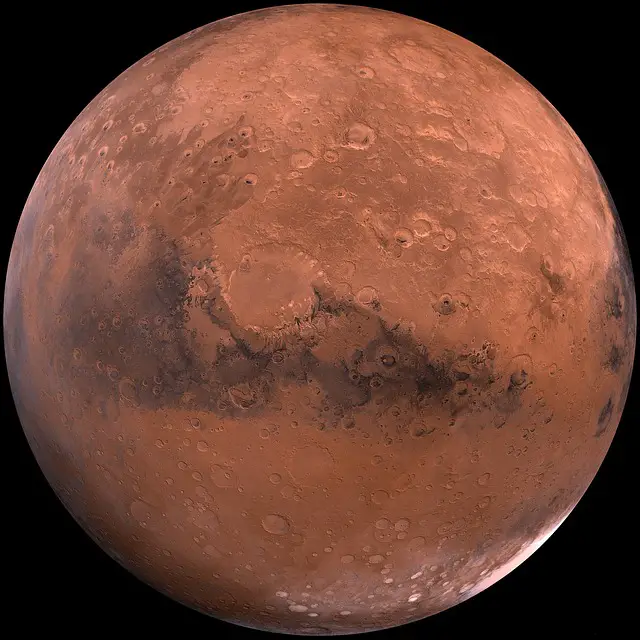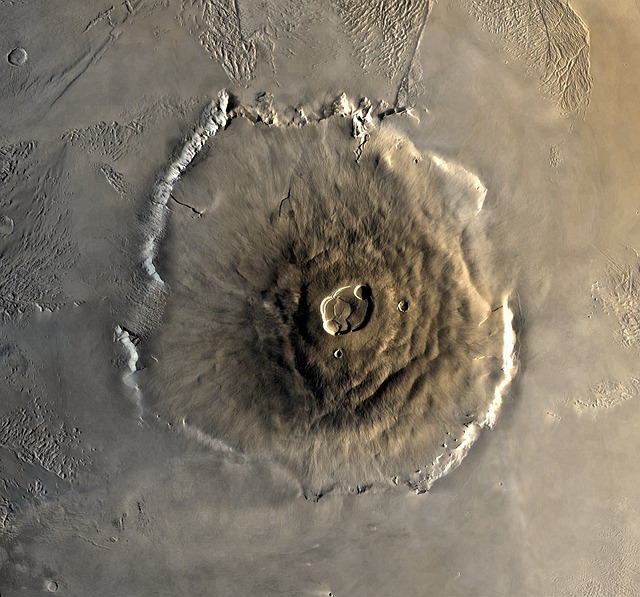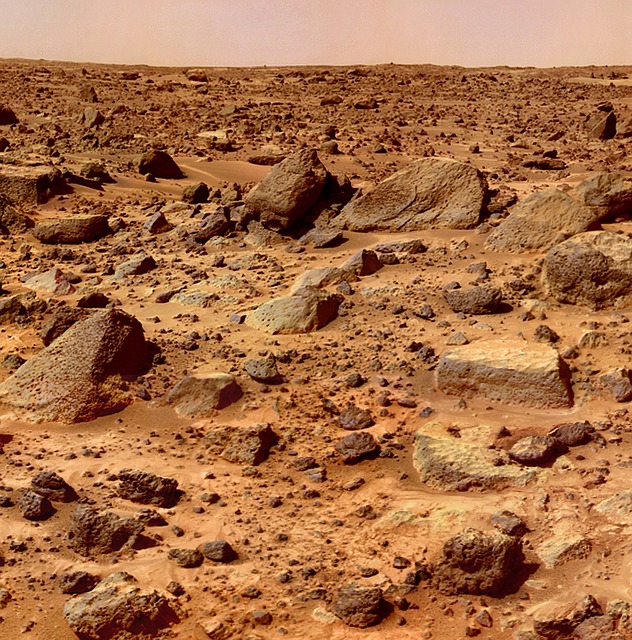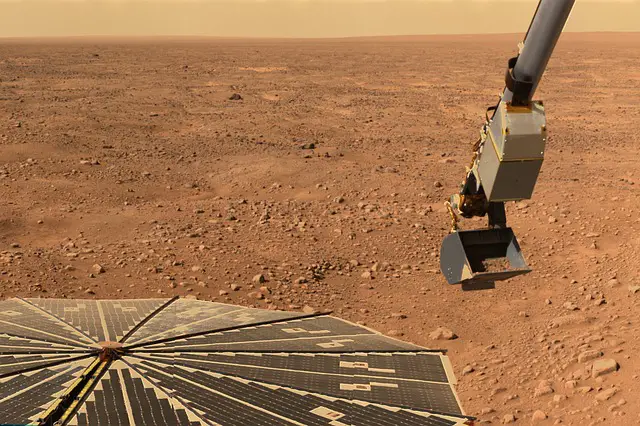Mars, the red planet, has captivated the interest of humans for centuries. It is one of the closest planets to Earth, and its mysterious red hue has made it an object of fascination throughout history.
With its notable features such as the polar ice caps, volcanoes, and canyons, Mars is an interesting destination for exploration.
Scientists and researchers are eager to learn more about this planet, and many ambitious projects are currently underway to further our knowledge of the fourth planet from the Sun.
Introduction
The planet Mars has been studied since antiquity, and there is evidence that the ancient Sumerians were among the first to observe and record its features. Throughout the centuries, astronomers and scientists have continued to observe the planet, and in the nineteenth century, Italian astronomer Giovanni Schiaparelli used the newly invented telescope to map Mars. He named the various features of the planet, and although he was mistaken in confusing canals for actual features, his discoveries set the stage for future exploration.
The planet Mars has since been studied more extensively through telescope observations and unmanned spacecraft. In 1965, the first spacecraft to orbit the planet was launched, and since then, many more unmanned probes have been sent to explore the Martian surface. The Mariner 4 flyby provided the first up-close views of the planet in 1965, and in 1971, the first successful Mars lander, Mariner 9, was launched. In the following decades, more probes were sent to the planet, gathering data on the planet’s surface and atmosphere.

In addition to the unmanned probes, spacecraft sent to explore Mars have included rovers and landers that provide a more detailed view of the planet. The two most successful were the Spirit and Opportunity rovers, which were sent to Mars in 2004 and landed successfully in 2005. These rovers were able to explore the planet in unprecedented detail and provided valuable information about the Martian surface.
More recently, the Mars Reconnaissance Orbiter (MRO) was launched in 2005. The MRO has been used to map the entire surface of Mars and has provided important data about the planet’s surface features. It has also sent back photos that have helped to further our understanding of the planet.
Scientists are eager to continue exploring the planet and have ambitious plans for future missions. In 2020, the Mars 2020 mission will launch a rover that will collect and study samples of the planet’s surface and atmosphere, and in 2021, the Mars Perseverance rover will be sent to search for evidence of ancient microbial life. NASA is also planning for human exploration of the planet in the coming decades.
Exploring the planet Mars has been an ongoing journey of discovery and science. With every new mission, we learn more about this mysterious planet and the potential it holds for future exploration. In this article, we will explore the fascinating planet of Mars and discuss the scientific studies that have been done, the possibility of future exploration efforts, and the potential of human exploration of the planet.
Mars Geology
Exploring the planet Mars has been a source of fascination and mystery for centuries, and the planet features some of the most breathtaking geology of any other planet in the Solar System. From the impressive mountains and canyons to the mysterious red sand and rocks, it’s no wonder that millions of people are riveted by the idea of visiting the Red Planet.
The geology of Mars has been studied in detail over the last few decades and has revealed a variety of features that make the planet unique. The planet’s surface is composed of ancient volcanoes, impact craters, and mountain ranges that are often covered in red dust. The planet’s atmosphere is also largely composed of carbon dioxide, making it an inhospitable environment for life.
The climate of Mars is much colder and drier than that of Earth, making it difficult for liquid water to remain on the planet’s surface. This is due to the fact that Mars is much farther away from the sun, making it much colder and more difficult for liquid water to remain in its liquid form. However, the presence of small amounts of water on the planet’s surface indicate that it could have been much wetter in the past.
The geological features of Mars are incredibly varied and include a variety of impact craters, volcanoes, and mountain ranges. The most famous of these features is the Olympus Mons, a large volcano located on the planet’s equator that is three times larger than Mount Everest. Its sheer size is thought to be the result of its proximity to the planet’s magnetic pole.

The impact of meteorites on the planet’s surface is also well documented. Meteors have blasted through the planet’s surface, leaving behind huge craters and mountains. One of the most famous of these impact sites is the Gale Crater, which NASA has used to study the planet’s geology.
The geology of Mars is an incredible and complex phenomenon that has captivated the imaginations of scientists and space exploration enthusiasts around the world. From the ancient volcanoes and impact craters to the mysterious red dust and rocks, it is an incredible and awe-inspiring place. And although it is a hostile environment for humans, the possibilities for further exploration and discovery are endless.
The Solar System and Mars
The solar system is made up of eight planets, including the planet Mars, numerous moons, asteroids, meteors, comets and more. It is believed that the entire system was formed approximately 4.6 billion years ago from a massive cloud of gas and dust. Mars was the fourth planet from the sun, and is the only other world in the solar system believed to have once harbored liquid water on its surface.
Mars is the seventh largest planet in the solar system, and its diameter is roughly half of Earth’s. It is a rocky world with a thin atmosphere that is filled with dust and carbon dioxide.
Its surface is red due to the presence of iron oxide, otherwise known as rust. Mars has two moons, named Phobos and Deimos, that appear to be asteroids captured by the planet’s gravity.
The climate and atmosphere of Mars are quite different from that of Earth. While Earth’s atmosphere is comprised mostly of nitrogen and oxygen, the atmosphere of Mars is very thin and consists mainly of carbon dioxide. The average temperature on Mars is -81 degrees F (-63 degrees C), and it has an orbital period of 687 Earth days.
The geological features of Mars were carved by the force of wind and water. Millions of years ago, Mars featured rivers, lakes, and an ocean. The planet is now covered in craters, canyons, volcanoes, and vast deserts. The impact of meteorites on Mars is also substantial, with a large impact crater on the planet’s surface known as the Hellas Basin.
Understanding the relationship between Mars and Earth is important for understanding the entire solar system. Mars and Earth are both members of the inner solar system, making up the two planets closest to the sun.

The two planets are also similar in size and composition. Mars is sometimes referred to as the “red planet” due to its rusty red color, while Earth is referred to as the “blue planet” due to its deep blue oceans.
The climates and atmospheres of all the planets in the solar system are different, but they share some similarities. All the planets experience some form of weather, and all of them orbit around the sun.
The presence of an atmosphere is key to understanding a planet’s climate, and the atmospheres of all of the planets in the solar system are composed of different gases and particles.
The possibility of life on other planets is still a subject of much speculation. Scientists have yet to find any evidence of life beyond Earth, but there is still much to be explored in the vast reaches of the solar system.
The discoveries made in the study of Mars will help us understand the possibility of life in outer space.
Space Exploration
Since the dawn of civilization, humans have been captivated by the cosmos and have been driven to explore the unknown. Space exploration is the use of science and technology to explore outer space and has been a major part of human history. The exploration of Mars is especially important, as it is the fourth planet from the sun and the closest to Earth, and has captivated the human imagination for centuries.
The history of space exploration is a long and varied one. Since the 1950s, the US and Soviet Union have been engaged in a space race to explore and understand the final frontier. The two countries have launched dozens of probes and satellites to explore different regions of the solar system, including Mars.
One of the most successful missions to Mars was the Viking mission in 1975, which sent two landers to the planet’s surface and returned data about the planet’s atmosphere, surface, and potential for life.
In recent years, the exploration of Mars has intensified. The Mars Exploration Rover (MER) mission, launched in 2003, sent two rovers to the Martian surface to explore the planet’s geology in unprecedented detail. The mission was a major success and provided insight into the history and evolution of the planet.
In addition, a number of other spacecraft have been sent to explore the planet. The Mars Science Laboratory (MSL), launched in 2011, is a robotic rover designed to explore and analyze the Martian environment. The MSL is still active and has provided crucial data about the planet’s history and habitability.
The exploration of Mars continues today. Several nations have sent spacecraft to explore the planet, including the United States, India, and the European Space Agency. These spacecraft have been used to map the planet’s terrain, analyze the atmosphere, and search for signs of life.
Perhaps most famously, the United Arab Emirates and China have each sent spacecraft to Mars, with the UAE’s Hope mission arriving in 2021 and the Chinese Tianwen-1 mission coming in 2021.
The exploration of Mars is an important part of human history, and it is only the beginning. As humanity’s knowledge of the Martian environment increases, we can better understand the planet and its potential for future exploration. The exploration of Mars holds immense promise for humanity, for it may hold the key to our understanding of the universe and our place in it.
Mars Research
The exploration of Mars is not just about discovering its past and current state, but it’s also about understanding its potential for the future. Through research, we can unlock the secrets of Mars and uncover the possibilities for life on the Red Planet.
Research into Mars has been ongoing since the 1950s when the spacecraft Mariner 4 first sent back images of the Martian surface. Since then, countless satellites, rovers, and orbiters have been sent to the Red Planet to study its geology, atmosphere, and potential for hosting life.
By studying the rocks and soils of Mars, researchers have been able to gain an understanding of the planet’s geological history. We now know that Mars was once much wetter than it is today and had an atmosphere that was capable of supporting liquid water. This knowledge has helped us to understand how Mars may have been hospitable to life in the past.
The atmosphere of Mars is still being studied to understand its impact on the possibility of life on the planet. The atmosphere on Mars is much thinner than the atmosphere on Earth, making it difficult for liquid water to remain on the surface. Researchers are also looking into the impact of meteors and micrometeorites on the Martian atmosphere and how this can affect the possibility of life on the planet.

The search for life on Mars has also been a major focus of Mars research. To date, a number of missions have been sent to the Red Planet to search for evidence of past and present life. The results of these missions have been inconclusive, but they have helped us to gain an understanding of the conditions that may be necessary for life on Mars.
The search for life on Mars isn’t just about looking for organisms, but also about studying the planet’s potential to host life in the future. Researchers have been looking into the possibility of terraforming Mars or creating an environment that is hospitable to life.
This would involve pumping greenhouse gases into the Martian atmosphere to increase the temperature and create artificial habitats for humans and other organisms.
Mars research is also focused on understanding the challenges of living and working on the planet. Astronauts who visit the planet will need to understand the environment and the possible dangers they may face. This includes studying the effects of radiation on humans, testing the viability of food sources, and looking into the possibilities of creating shelters and habitats to protect against the cold and radiation.
Overall, Mars research is an essential part of our understanding of the Red Planet. By studying the planet’s past and present state, we can gain insight into its potential for the future.
Through research, we can unlock the secrets of Mars and uncover the possibilities for life on the Red Planet.
Humans on Mars
The prospect of humans visiting or even living on Mars is an exciting one. It is a natural step in our exploration of the universe and could open up a wealth of opportunities and insights. It could also present some major challenges.
To begin with, the environment on Mars is unlike anything on Earth. It is cold, dry and highly irradiated. The atmosphere is thin and lacks oxygen, requiring humans to wear protective suits and rely on other forms of oxygen delivery. The gravity on Mars is only one-third of Earth’s, which could lead to various medical complications and bone density problems for astronauts. These issues would have to be addressed before any long-term expeditions or colonization attempts could be considered.
Once these issues are resolved, there are many potential benefits of human exploration on Mars. For one, humans could conduct research in person, rather than relying on robotic probes. This would give scientists more direct access to the Martian environment, as well as the ability to perform experiments with greater accuracy and complexity.
Additionally, any human presence on the planet would be a major technological and political achievement and could spur new developments and economic growth.
Of course, any human presence on Mars would require extensive planning and resources. Establishing a base of operations on Mars would take a great deal of time and money, including the development of technologies to support living on the planet. The costs would need to be weighed against the potential benefits of human exploration, and a viable strategy for living in the Martian environment would have to be devised before any serious efforts could be made.
Finally, if humans are to live and work on Mars, there would be numerous ethical considerations to take into account. This could include protecting the environment, the welfare of workers, and the rights of any future Martian inhabitants. The debate would likely arise over questions such as who should be allowed to visit or settle on the planet, and what the goals and restrictions of such activities should be.
In conclusion, the prospect of humans exploring or even inhabiting Mars is both exciting and daunting. There are numerous potential benefits to human exploration of the planet, but there are also many challenges to be considered. Careful planning and research will be necessary to ensure that any human presence on Mars is safe and beneficial.
Conclusion
Exploring Mars has been one of mankind’s greatest endeavors. Through a combination of unmanned probes and spacecraft, experiments conducted by robotic rovers, and research conducted by scientists all around the world, we have gained valuable insights into the Red Planet.
We have discovered vast and diverse landscapes, studied the composition of the Martian atmosphere, and even explored the possibility of life beyond Earth.
The exploration of Mars has had a significant impact on our understanding of the universe and our place in it. We now have a better understanding of the formation of planets and the possibility of life on other worlds. We can also appreciate the importance of our own planet and the necessity of preserving it for future generations.
The future of Mars exploration is an exciting one. We are currently exploring the possibilities of human exploration of the planet, and many of the plans are already in motion. By learning more about the Martian environment, studying its geological features, and conducting research on the planet, we can gain a better understanding of our own solar system and the universe beyond.
Mars research is also essential to our understanding of the planet. The research conducted on Mars has enabled us to gain a better understanding of its geology, atmosphere, and potential for life.
Through these studies, we have gained valuable insights into our own solar system and the possibility of life on other planets.
The prospect of humans living and working on Mars is a captivating one. While we have yet to achieve this, the potential benefits of establishing a human presence on the planet are immense. From gaining a better understanding of the Martian environment to furthering our knowledge of space exploration, the possibilities are limitless.
Ultimately, the exploration of Mars is a journey of discovery and science. Through a combination of research, exploration, and space exploration, we are gaining valuable insights into our own solar system and the universe beyond.
In the coming years, we can expect to see significant advancements in our understanding of Mars and the possibilities of life on other planets.
Links
We have a variety of interesting facts about Mars that you can enjoy right here – Various facts about the planet Mars
